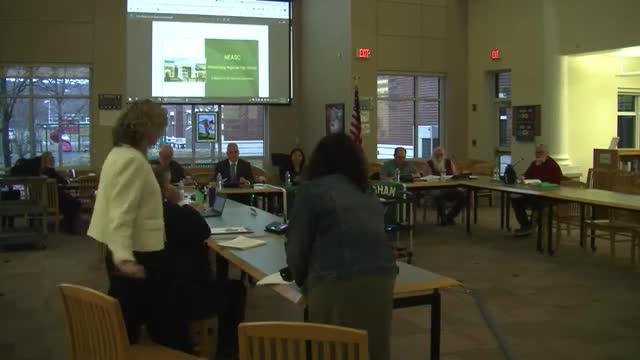NEASC decennial visit praises Minnechaug High; report recommends deeper K–12 alignment and funding for facilities and staffing
March 21, 2025 | Hampden-Wilbraham Regional School District, School Boards, Massachusetts
This article was created by AI summarizing key points discussed. AI makes mistakes, so for full details and context, please refer to the video of the full meeting. Please report any errors so we can fix them. Report an error »

Minnechaug Regional High School staff reported on the schools recent New England Association of Schools and Colleges (NEASC) decennial visit and the resulting accreditation report at the March 20 Hampden-Wilbraham Regional School Committee meeting. District presenters said the school met NEASCs five standards during a multiyear review that began with a self-study in 2020 and included visits in 2022 and 2024.
The NEASC process is an external and internal evaluation that examines programs against a set of standards and 169 descriptors of effective practice, district presenters said, and it culminates in an accreditation decision and a set of recommendations the school will report back on in 2026, 2028 and 2031.
The report highlighted several strengths at Minnechaug, presenters said: an emphasis on a schoolwide "vision of the graduate" built around the values Challenge, Honor, Adapt, Understand and Grow (CHaD); an expanded set of tiered academic interventions, including interventionists in English and math; a growing co-teaching program (presenters said 17 co-taught classes this year across subjects); broad community partnerships and numerous hands-on shop/course experiences (presenters tallied about 1,300 hands-on experiences this school year, for a student body of about 982). The report also praised the schools technology integration and library services and commended visible school leadership and staff recognition practices.
NEASC evaluators identified areas for continued growth. The report recommended deeper K–12 alignment to embed the vision of the graduate across all grades, further development of multi-tiered systems of support (academic and social-emotional), sustained professional development time and resources, and securing longer-term funding to address aging facilities and growing staffing needs. Presenters told the committee these recommendations will inform the districts continuous improvement planning and future reports required by NEASC.
District staff noted the accreditation process has been resource intensive: the district has budgeted approximately $10,000 per year for NEASC-related work (including association dues and costs tied to site visits). Committee members and presenters discussed ways to share the work with other districts, including faculty visits to other schools and encouraging district staff to serve as NEASC evaluators, which committee members said both support professional development and cross-district learning.
District presenters said the report validates ongoing instructional work while also clarifying next steps that carry resource implications for facilities upkeep, instructional materials and training for trauma-informed and tiered instruction.
Committee members thanked the school staff for the work and asked for follow-up reporting to tie NEASCs recommendations into the districts multi-year budget and facility plans.
The NEASC process is an external and internal evaluation that examines programs against a set of standards and 169 descriptors of effective practice, district presenters said, and it culminates in an accreditation decision and a set of recommendations the school will report back on in 2026, 2028 and 2031.
The report highlighted several strengths at Minnechaug, presenters said: an emphasis on a schoolwide "vision of the graduate" built around the values Challenge, Honor, Adapt, Understand and Grow (CHaD); an expanded set of tiered academic interventions, including interventionists in English and math; a growing co-teaching program (presenters said 17 co-taught classes this year across subjects); broad community partnerships and numerous hands-on shop/course experiences (presenters tallied about 1,300 hands-on experiences this school year, for a student body of about 982). The report also praised the schools technology integration and library services and commended visible school leadership and staff recognition practices.
NEASC evaluators identified areas for continued growth. The report recommended deeper K–12 alignment to embed the vision of the graduate across all grades, further development of multi-tiered systems of support (academic and social-emotional), sustained professional development time and resources, and securing longer-term funding to address aging facilities and growing staffing needs. Presenters told the committee these recommendations will inform the districts continuous improvement planning and future reports required by NEASC.
District staff noted the accreditation process has been resource intensive: the district has budgeted approximately $10,000 per year for NEASC-related work (including association dues and costs tied to site visits). Committee members and presenters discussed ways to share the work with other districts, including faculty visits to other schools and encouraging district staff to serve as NEASC evaluators, which committee members said both support professional development and cross-district learning.
District presenters said the report validates ongoing instructional work while also clarifying next steps that carry resource implications for facilities upkeep, instructional materials and training for trauma-informed and tiered instruction.
Committee members thanked the school staff for the work and asked for follow-up reporting to tie NEASCs recommendations into the districts multi-year budget and facility plans.
View full meeting
This article is based on a recent meeting—watch the full video and explore the complete transcript for deeper insights into the discussion.
View full meeting
